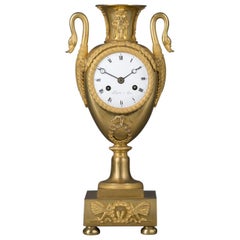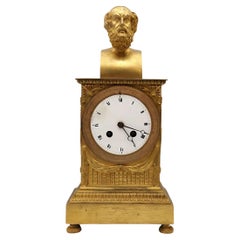Pierre-Basile Lepaute Mantel Clocks
to
1
1
1
1
1
1
1
1
Height
to
Width
to
1
1
1
1
34
30
18
17
Creator: Pierre-Basile Lepaute
Empire Clock in the Form of a Classical Urn, by Maison Lepautre, circa 1825
By Pierre-Basile Lepaute
Located in Brighton, West Sussex
A gilt bronze Empire clock in the form of a classical urn, by Maison Lepautre.
French, circa 1825.
The dial signed 'Lepaute a Paris'.
The clock has an ornate cast bezel with a 3-inch porcelain dial with Roman numerals and Breguet style hands. The twin train eight-day movement with outside count wheel striking on a bell and silk thread suspension.
This elegant Empire style clock has a gilt bronze case in the form of a classical urn with swan neck handles and a winged cherub to the neck. The circular pedestal base is raised on a footed stepped square plinth.
The Lepaute family were the premier French clockmakers of their day. Their significance lies in their contribution to the clock making industry which had hitherto come under the trade of locksmiths. The family held the brevet Horlogers du Roi.
Jean-André Lepaute (1720–1789) arrived in Paris at an early age and in 1740 founded the family business. A skilled artist and mechanic, he quickly gained an excellent reputation. He was received as maître by the clockmakers guild in 1759, was granted royal lodgings from the king in The Luxembourg Palace, and was entrusted with the construction of the majority of the great public clocks of Paris. He executed, amongst others, those in The Luxembourg Palace, the Jardin des Plantes, the Château de Bellevue and the Château des Ternes. His clock at Paris’s École Militaire still works today. Three editions of his Traité d’Horlogerie were published in Paris in 1755, 1760 and 1767. A small volume, Description de Plusieurs Ouvrages d’Horlogerie appeared in 1764. Jean-André’s wife, Nicole-Reine Etable de la Brière (1723-1788), was a highly esteemed mathematician and astronomer. Her passion for science lent itself to Lepaute’s work and she played an active role in the scientific and mathematical aspects of the clock making.
Jean-André’s younger brother Jean-Baptiste Lepaute (1727-1802) joined him in Paris in 1747 and immediately started working for the family business. He was received as maître in 1776 and was known for the clocks he constructed for the Paris Hôtel de Ville (1780), destroyed in a fire of 1871, and for the Hôtel des Invalides (1784). Jean-Baptiste took over the workshop when Jean-André retired in 1775.
After Jean-Baptiste’s death in 1802, the firm was taken over by his nephew Pierre-Basil Lepaute (1750-1843) where he was duly joined by his own nephew Jean-Joseph (1768-1846) and son Pierre-Michel (1785-1849). By 1816, Pierre-Michel Lepaute was in charge of the business. His masterpieces include the astronomical clock in Paris’s Bureau...
Category
Early 19th Century French Empire Antique Pierre-Basile Lepaute Mantel Clocks
Materials
Bronze
Related Items
A Homer bust ormolu empire clock in the manner of Thomire
By Pierre-Philippe Thomire
Located in Harrington Park, NJ
AN EMPIRE ORMOLU BUST OF HOMER
After the Antique
The bearded bust of Homer on a rectangular clock decorate with lyres and gryphon heads on the side
Category
Early 19th Century French Empire Antique Pierre-Basile Lepaute Mantel Clocks
Materials
Bronze, Ormolu
French Classical Mantel Clock, circa 1880
Located in Brighton, Sussex
An enchanting classical Louis XVI style gilded ormolu and marble mantel clock, having a standing cherub holding a Cockerel above a white enamel clock face, retails name; Rob. Engstro...
Category
19th Century French Louis XVI Antique Pierre-Basile Lepaute Mantel Clocks
Materials
Marble, Ormolu
French Empire Style Mantel Clock, circa 1820
Located in Brighton, Sussex
A very impressive and stylish early 19th Century gilded ormolu and green marble mantle clock, having two classical maidens either side feeding Rams, an Eagle above the circular white...
Category
Early 19th Century French Empire Antique Pierre-Basile Lepaute Mantel Clocks
Materials
Marble, Ormolu
The Astronomy Lesson French Empire Mantel Clock
Located in New Orleans, LA
This magnificent French Empire ormolu mantel clock features the iconic Neoclassical genre scene often referred to as "The Astronomy Lesson." A popular motif during this period, Emper...
Category
19th Century French Empire Antique Pierre-Basile Lepaute Mantel Clocks
Materials
Marble, Enamel, Ormolu
French Empire Gilt Bronze Allegorical Clock of the Astronomical Sciences
Located in Vancouver, British Columbia
A fine example of a period French Empire mantle clock in finely chased and gilded bronze made in France in the first quarter of the 19thC. One of the Greek muses with a star atop h...
Category
Early 19th Century French Empire Antique Pierre-Basile Lepaute Mantel Clocks
Materials
Bronze
$3,200
H 15 in W 11 in D 4 in
Allegorical French Empire Clock Referred to as "The Library Clock"
Located in Vancouver, British Columbia
A rare model of a French Empire clock in gilded bronze called The Library, featuring a boy and a girl dressed in classical attire diligently studying in a library, both are sitting on a stool in front of a clock which is integrated into a column which also serves as a bookshelf. The oval clock...
Category
Early 19th Century French Empire Antique Pierre-Basile Lepaute Mantel Clocks
Materials
Bronze
Clock in Gilt Bronze, Empire Period
Located in Saint-Ouen, FR
Clock in chiselled and gilt bronze composed by a rectangular base on which stand the dial-plate and a statuette of Bacchus. Round dial-plate with Roman numbers off-center on the righ...
Category
19th Century European Empire Antique Pierre-Basile Lepaute Mantel Clocks
Materials
Bronze
Clock Pendulum Empire France
Located in New York, NY
Table pendulum clock made in France during the empire period, 1790-1810. Made from gilt bronze. Depicting a man holding a cornucopia.
Category
Early 19th Century French Empire Antique Pierre-Basile Lepaute Mantel Clocks
Materials
Bronze
French Empire Period Ormolu Bronze Mantel Clock of Ceres, circa 1815
Located in Shippensburg, PA
A fine Empire period mantel clock with bun feet raising a rectangular base with a central portrait of Bacchus flanked by exquisitely chiseled motif of swirling foliage surmounted by a figure of the goddess Ceres grasping in her lowered hand a wreath woven with foliage and berries while in her garment she collects a bountiful harvest; she rests beside the clock tower with a framed lens opening to access the white enamel dial with black Roman numerals inscribed Etn. Tavernier set with Breguet style hands, raising an urn filled with fruits of the soil; against the tower rest the implements of labor, a shovel and flat rake. The movement is engraved "B". A significant clock movement maker, Etienne Tavernier (French, 1756-1839) is listed in Tardy's horology reference as working closely with the house of Abraham-Louis Breguet as well as providing clock movements...
Category
19th Century French Empire Antique Pierre-Basile Lepaute Mantel Clocks
Materials
Bronze, Ormolu
$3,850
H 17.25 in W 12.99 in D 5 in
Grand French Gilt and Patinated Bronze Mantel Clock in the Empire Style
Located in London, GB
Constructed in bronze, patinated and gilt; the rectangular form case supported on engraved oblate spherical feet, the frieze dressed with a row of female masks capping pillars, linke...
Category
19th Century English Empire Antique Pierre-Basile Lepaute Mantel Clocks
Materials
Bronze, Ormolu
$75,723
H 28 in W 30 in D 10.5 in
19th Century Clock Empire Clock in Siena Marble
Located in Madrid, ES
XIX CENTURY CLOCK EMPIRE CLOCK IN SIENA MARBLE AND DECORATED WITH BRONZE. SUSPENSION MECHANISM WITH FILE. COMPLETE WITH ITS KEY AND PENDULUM. MEASURES: 45 CM HIGH
good condition.
Category
19th Century French Empire Antique Pierre-Basile Lepaute Mantel Clocks
Materials
Marble
Patinated and Fire-Gilt Clock in the Form of a Vase c. 1800
Located in 263-0031, JP
A French patinated and fire-gilt clock in the form of a vase, Empire Era, 1800-1815. The silk-thread mechanism is in good working condition with key and pendulum.
Category
Early 19th Century French Empire Antique Pierre-Basile Lepaute Mantel Clocks
Materials
Bronze
$2,064 Sale Price
20% Off
H 15.36 in W 4.93 in D 3.94 in
Pierre-basile Lepaute mantel clocks for sale on 1stDibs.
Pierre-Basile Lepaute mantel clocks are available for sale on 1stDibs. These distinctive items are frequently made of metal and are designed with extraordinary care. There are many options to choose from in our collection of Pierre-Basile Lepaute mantel clocks, although gold editions of this piece are particularly popular. Many of the original mantel clocks by Pierre-Basile Lepaute were created in the Empire style in france during the 19th century. If you’re looking for additional options, many customers also consider mantel clocks by and Jean-Simon Deverberie. Prices for Pierre-Basile Lepaute mantel clocks can differ depending upon size, time period and other attributes — on 1stDibs, these items begin at $5,301 and can go as high as $5,301, while a piece like these, on average, fetch $5,301.


